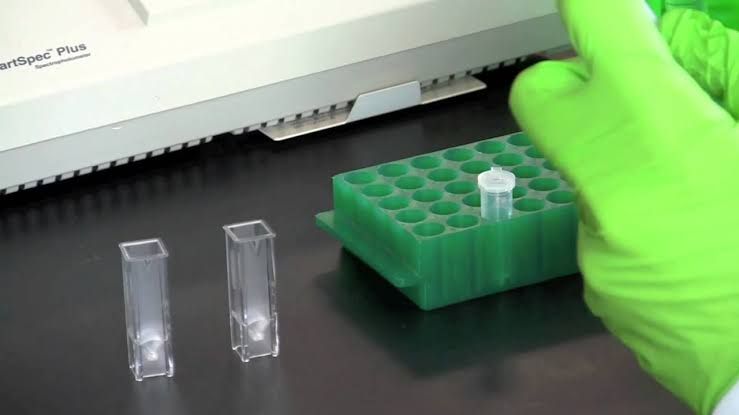
Quantification of DNA by spectrophotometry involves several key steps that ensure accurate measurement of DNA concentration and purity. The following is a detailed step-by-step procedure:
1. Sample Preparation
Before quantifying DNA, it is essential to prepare the sample properly:
- Dilution: If the DNA concentration is expected to be high, dilute the sample in a low-salt buffer (e.g., 10 mM Tris·Cl, pH 7.5) to achieve an absorbance reading within the optimal range (0.1 to 1.0 at 260 nm). This dilution helps avoid saturation of the spectrophotometer’s detector.
- Cuvette Selection: Use a quartz cuvette for measurements, as it allows UV light to pass through without significant absorption.
2. Calibration of the Spectrophotometer
Before taking measurements, calibrate the spectrophotometer:
- Blank Measurement: Fill a cuvette with the same buffer used for diluting the DNA sample and place it in the spectrophotometer. Set this as the blank to zero out any background absorbance from the buffer itself.
3. Measurement of Absorbance
Once calibration is complete, proceed with measuring the absorbance:
- A260 Measurement: Insert the cuvette containing your diluted DNA sample into the spectrophotometer and measure absorbance at 260 nm (A260). Pure DNA absorbs light maximally at this wavelength.
- A280 Measurement: Measure absorbance at 280 nm (A280) to assess protein contamination. Proteins also absorb UV light but have a peak around this wavelength.
- A230 Measurement: Optionally, measure absorbance at 230 nm (A230) to check for contamination by chaotropic salts or other organic compounds that may interfere with downstream applications.
4. Calculation of DNA Concentration
Using the absorbance readings obtained, calculate the concentration of DNA:
- Using A260 Value: The concentration can be calculated using the formula: Concentration (µg/ml) = A260 × conversion factor
The conversion factor for double-stranded DNA (dsDNA) is typically 50 µg/ml per A260 unit measured in a standard path length of 1 cm.
5. Assessment of Purity
Evaluate the purity of your DNA sample based on absorbance ratios:
- A260/A280 Ratio: Calculate this ratio to assess protein contamination:
- Pure dsDNA has an A260/A280 ratio between approximately 1.8 and 2.0.
- A260/A230 Ratio: This ratio helps identify contamination from phenol or other contaminants:
- Pure dsDNA typically has an A260/A230 ratio greater than 2.0.
6. Interpretation of Results
Analyze your results based on calculated concentrations and purity ratios:
- If either ratio indicates contamination (e.g., A260/A280 <1.8), consider further purification steps before proceeding with downstream applications such as PCR or sequencing.
- Document all findings meticulously for reproducibility and reference in future experiments.
By following these steps carefully, researchers can achieve reliable quantification and assessment of DNA samples using spectrophotometry, ensuring that they are well-prepared for subsequent molecular biology applications.







